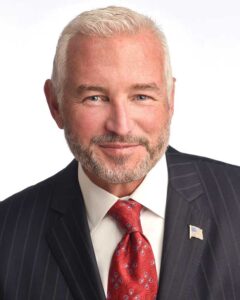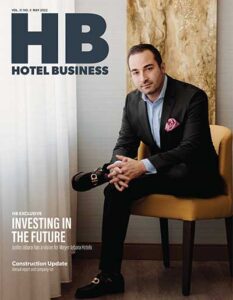As the hospitality industry continues its return from the COVID-19 pandemic, new-build construction and renovations have jumped into a new gear. Like so many other industries, labor and supply shortages are among several issues that are affecting work. Hotel Business spoke with Randy Shelly, EVP, hospitality, Shawmut Design and Construction; Robert Smith, CEO/chief satisfaction officer, The Allied Group; and Bill Wilhelm, president, R.D. Olson Construction, to get their take on the state of construction and how projects are coming together in the post-pandemic world.
—Gregg Wallis
What do you see as the current state of hotel development? Are we back to 2019 building rates?
Shelly: We are not yet back to pre-pandemic rates, but owners are more bullish on pushing new plans—or plans that were put on pause due to the pandemic—forward. Once business travel picks back up, we anticipate construction coming back to pre-pandemic rates as the pipeline for 2023 is looking strong.
Smith: The Allied Group specializes in hotel renovations, and we have experienced a full recovery of project awards with a strong pipeline of opportunities at pre-pandemic levels. We believe that the industry is making a solid recovery and is being led by the return and pent-up demand for leisure and business travel. This equates to strong future demand for brand upgrades and future development.
Wilhelm: Not quite. We are currently seeing a handful of renovations and repositionings, but not yet at the level we were expecting. We have seen some interest from ground-up developers, but it is still a slow and lengthy process. We expect new-builds are still about six to eight months away from taking off.
Are you seeing more new-build projects or renovations happening?
Shelly: Although there are opportunities for ground-up construction, with our hotel work focused in New York City, Los Angeles, Miami, Boston and Las Vegas, the majority of projects in these urban cities are through the renovation or adaptive-reuse of existing buildings. In addition, with a large focus on carbon-emission reduction, hotels are looking to adapt, reuse and recycle existing buildings in an environmentally responsible way, reducing the energy and waste associated with demolishing and constructing new buildings.
Smith: As a company, The Allied Group is solely focused on renovating hotels, and we are having a banner year above 2021 outstanding levels. The industry metrics that we monitor support this activity level and indicate that the new-build pipeline is slowing due to the cost of new development, and the forecast for renovations is growing. This is further supported by the continued robust activity of portfolio repositioning, mergers & acquisitions and the return of brands upgrading to their standards.
Wilhelm: Currently, we are seeing more renovations. Many of the new-builds that are underway are destination resorts.
Have you seen changes to how projects are happening versus before the pandemic?
Shelly: Long lead times caused by supply chain issues have driven an increased focus on bringing the design and construction team together earlier in the project to plan and get ahead of procurement as a team. Shawmut created an in-house department, led by our director of preconstruction and estimating, that collects, analyzes and disseminates data in real-time to monitor and react quickly to changing conditions. These reports arm our project teams and clients with the latest information to make the best decisions based on the current market. This is layered on top of Shawmut’s existing best practices—early and frequent communication, upfront partnership, collaborative preconstruction, design-assist, effective value-engineering and flexibility from all key stakeholders—to avoid cost and time overruns.
Smith: The pandemic has significantly redefined the landscape of project delivery models. The industry is experiencing challenges in supply chain issues, skilled labor shortages, volatility in material pricing, product availability and long lead times. These challenges, coupled with inflation and global issues, create the demand for a plan A, B and the 24 other letters of the alphabet if needed.
Wilhelm: Yes. Many are looking for areas to improve both cost and efficiencies in operations. The entire perspective on what the end-user in the hospitality market is looking for is being reevaluated and a number of aspects, such as the check-in process and the addition of touchless elements, are being considered.
How are supply shortages and price increases affecting projects?
Shelly: While prices started to stabilize at the end of 2021, the war in Ukraine and Western sanctions have led to another round of price increases, with fuel, steel, aluminum, copper and wood increasing the most. Lead times on many items are at an all-time high—notably roof insulation, generators and DensGlass. Shawmut has taken a multi-pronged approach to addressing these challenges, from testing different construction method approaches—for example, we’re seeing MEPs coming prefabricated, with the installation all at once saving time and money— to relentlessly enforcing best practices. As a construction manager, we’ve always had to have a laser focus on the supply chain and material procurement, staying one step ahead just to ensure we deliver clients’ projects on time and within budget. We’ve taken this approach and mindset to an extremely heightened level—any material can be affected, and costs and lead times can shift in an instant, requiring instant action and problem-solving to deliver for our clients. Preconstruction has become even more critical, with design-assist and true value-engineering a collaboration among client, architect and Shawmut to react fluidly and effectively to current market conditions. This collaborative approach allows us to communicate early with subcontractors, bringing them on as quickly as possible to set a base for material costs. It also allows us to start procurement packages as early as possible, mitigating lead time and pricing risks.
Smith: The ongoing supply shortages and pricing volatility have made the budgeting and scheduling of projects significantly harder. Communication and collaboration between all stakeholders—from the owner, design, procurement teams and general contractor to the hotel operations—are critical. Teamwork in value engineering, creativity and looking ahead with a proactive mindset always convert to project success.
Wilhelm: The supply shortages are making it more difficult to hold budget, as well as manage and control schedule, regardless of what was initially approved.




